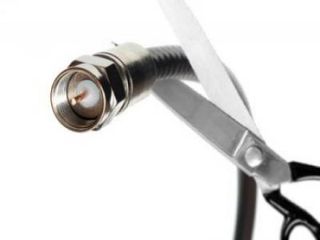Analyst: Record Cord Cutting Raises Concern for Media Stocks

Looking at the second-quarter financial and operating results released so far by cable operators, analyst Michael Nathanson of MoffettNathanson Research said cord-cutting has become “freaking ugly” and the headwinds faced by media companies have gotten “much worse.”

In a report Monday, Nathanson noted that despite the troubling fundamentals, most of the media stocks he covers--Disney, Discovery, Viacom and CBS-- have outperformed the S&P 500.
But so far this quarter Comcast, AT&T and Charter have reported losing more than 1.25 million subscribers. “As a result of this bloodshed, we are estimating that the rate of traditional cord-cutting will reach 5.5% in 2019 (the worst rate it has ever been),” Nathanson said.
"Even adding back virtual MVPD subscribers, the drop will be 2.7%, a new low,” he said, adding “we would expect that this trend will continue to accelerate over the back-end of 2019.”
Nathanson notes the subscriber trends might not be fully reflected in the upcoming second-quarter results to be released by media companies in the coming weeks because of a lag in the time it takes for them to get subscriber data from distributors.
He said that domestic affiliate fee growth for cable networks was 4% in the first quarter, down from 6% the previous two quarters. Q2 “will likely be the weakest cable network affiliate fee growth quarter on record,” he said. Retransmission fee growth for broadcasters remains strong, he added.
The C3 ratings used to sell advertising were down 13% in the quarter, Nathanson notes, with broadcast networks down 9% and cable dropping 14%.
Broadcasting & Cable Newsletter
The smarter way to stay on top of broadcasting and cable industry. Sign up below
“The growth of cord-cutting and the continued decline in viewership are creating an interesting dynamic on the average reach and length of tune-in on an individual network basis,” Nathanson said.
Over five years, the reach of broadcast networks is down 17% to 60.2% and cable networks are down 7% to 12.5%. On cable the biggest reach losers have been general entertainment networks.
At the same time, Nathanson notes, the length of time each viewer spends tuned in to an individual network has gone up, with broadcast rising to 32.2 minutes from 28.1 minutes over those five years. Cable length-of-tune increases to 23.7 minutes from 20.4 minutes. He says this is because the people who have not cut the cord are TV’s most passionate fans.
While most networks have lost reach but gained length of tune, a handful of networks have gained both reach and length of tune. Those are all newer networks: INSP, Motor Trend, Discovery En Espanol and Discovery Family. A few have lost both reach and length of tune, including Viceland, Universal Kids, Hallmark Movies and Mysteries, Investigation Discovery, MTV Classic and TNT.
Nathanson is forecasting that national advertising will be flat in the second quarter, with cable up 1% to $5.6 billion and broadcast down 1% to $3.2 billion.
So far, Wall Street has bought into media companies’ plans to get into streaming and rely more on live programming, but Nathanson doesn’t seem to be sure how long that can last.
“While we applaud our companies’ efforts to turn their stories around and build their respective lifeboats for the future,” he said. “The data points should raise serious concern over the rate of decay of the traditional ecosystem Man the lifeboats!”
Jon has been business editor of Broadcasting+Cable since 2010. He focuses on revenue-generating activities, including advertising and distribution, as well as executive intrigue and merger and acquisition activity. Just about any story is fair game, if a dollar sign can make its way into the article. Before B+C, Jon covered the industry for TVWeek, Cable World, Electronic Media, Advertising Age and The New York Post. A native New Yorker, Jon is hiding in plain sight in the suburbs of Chicago.

